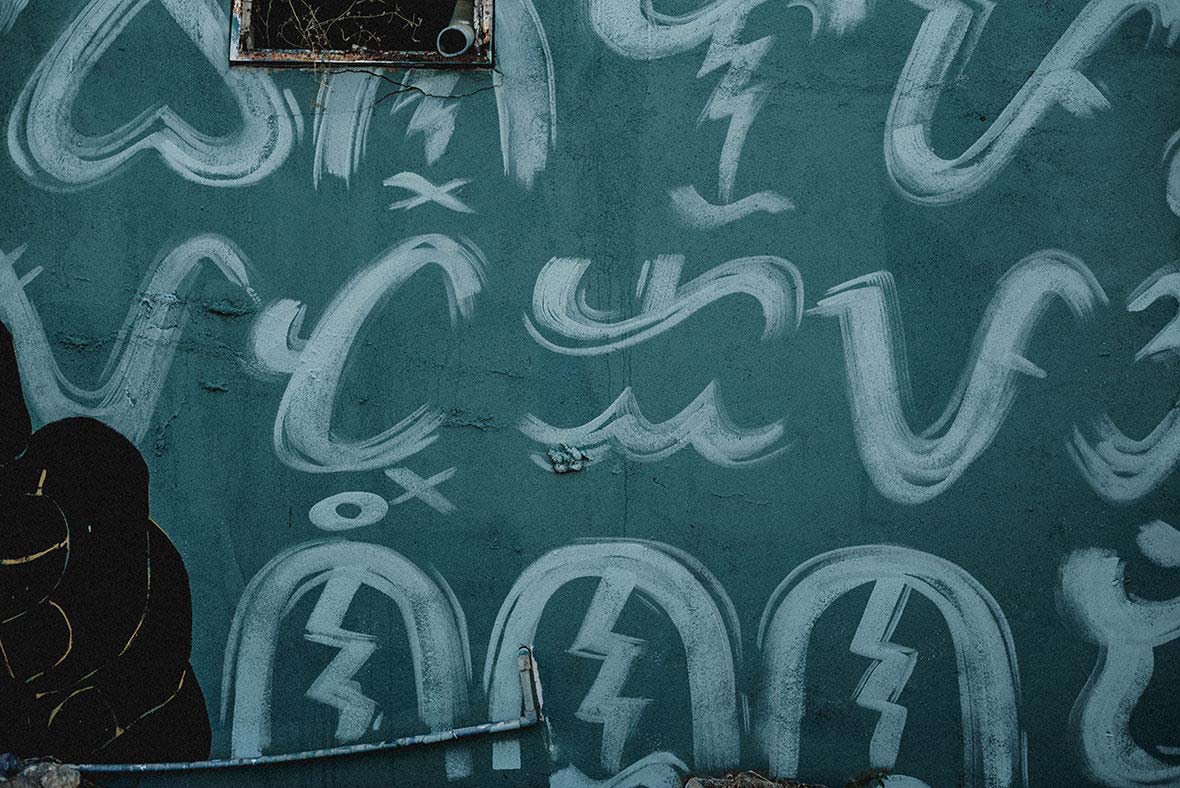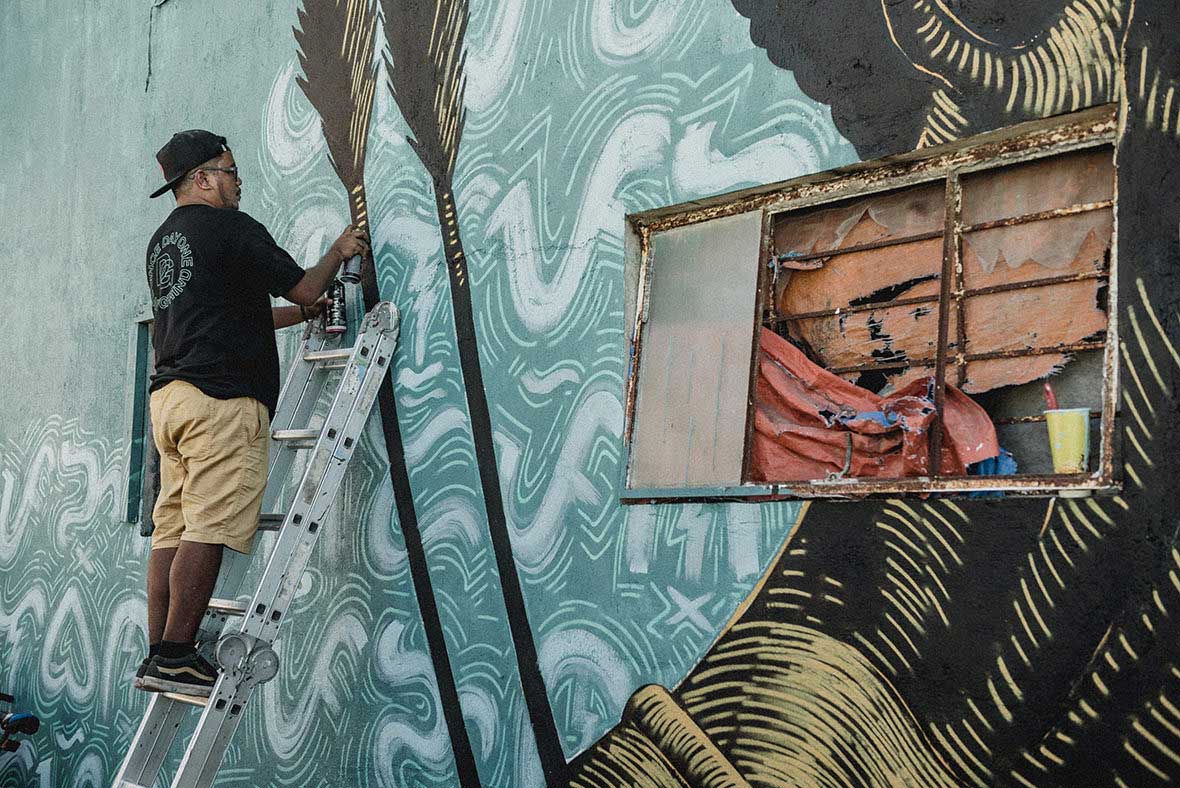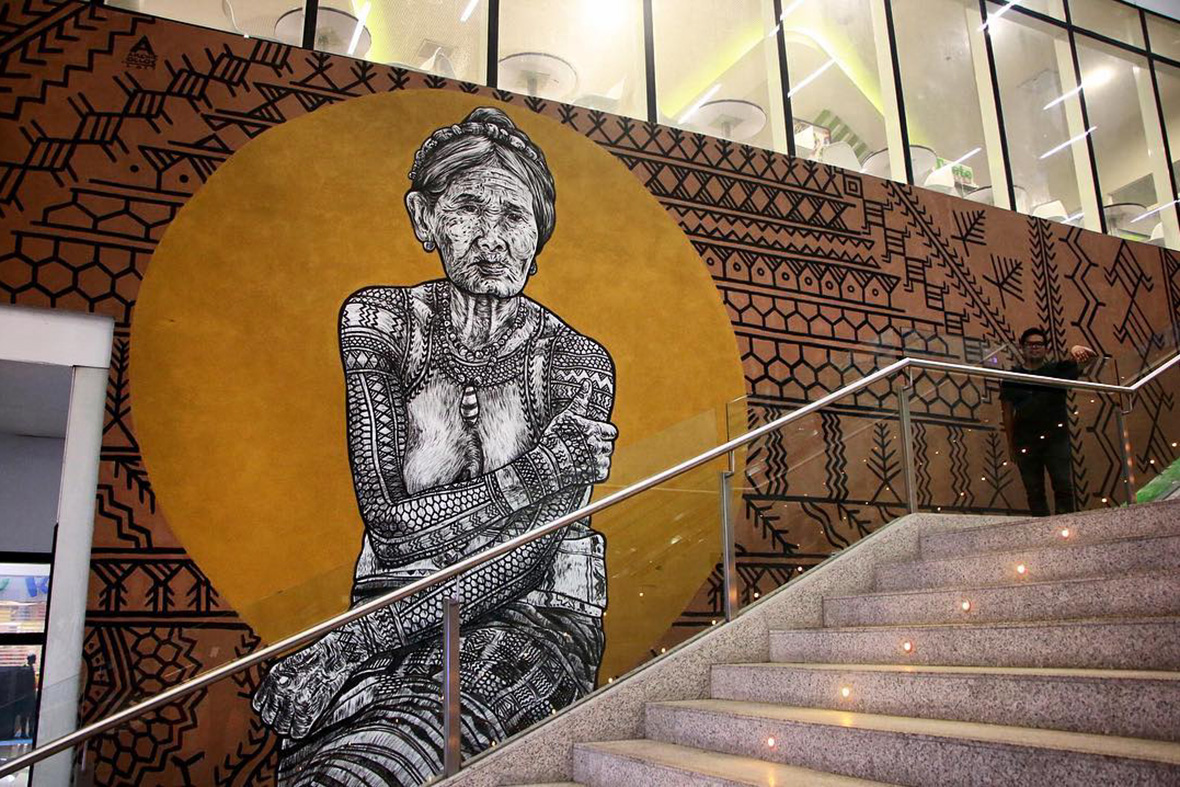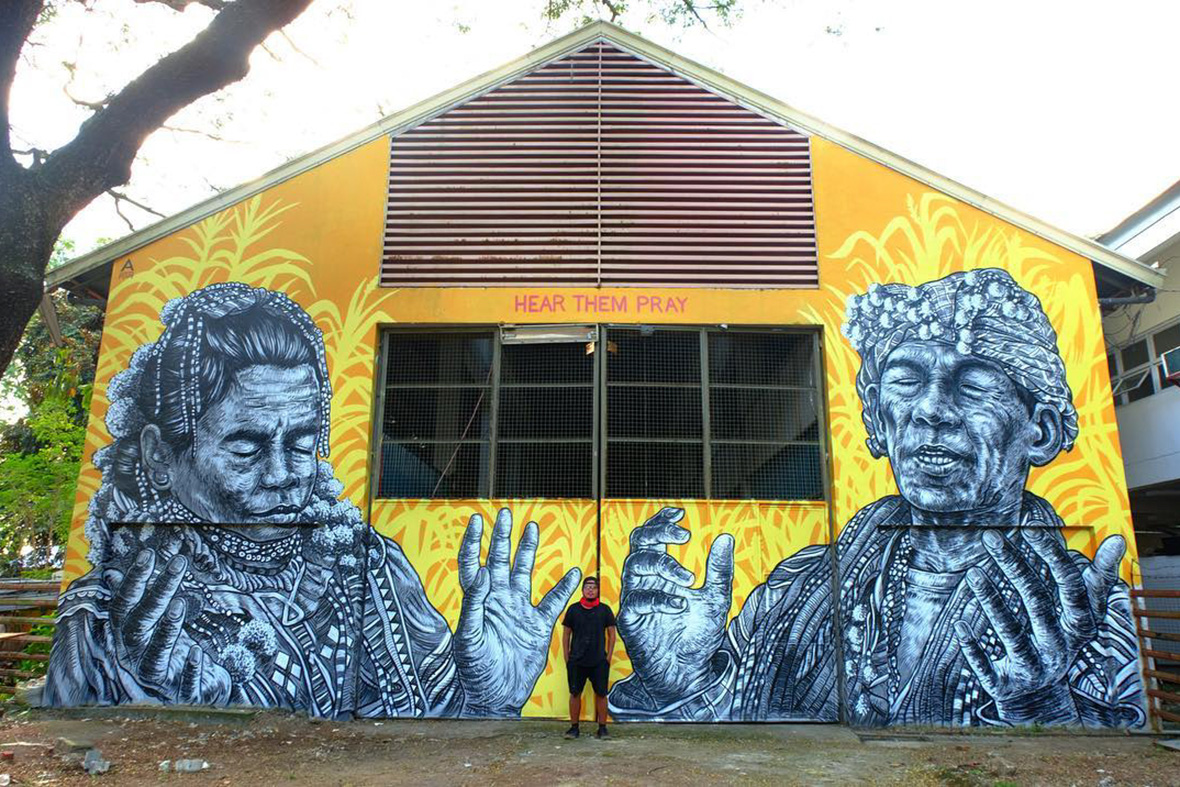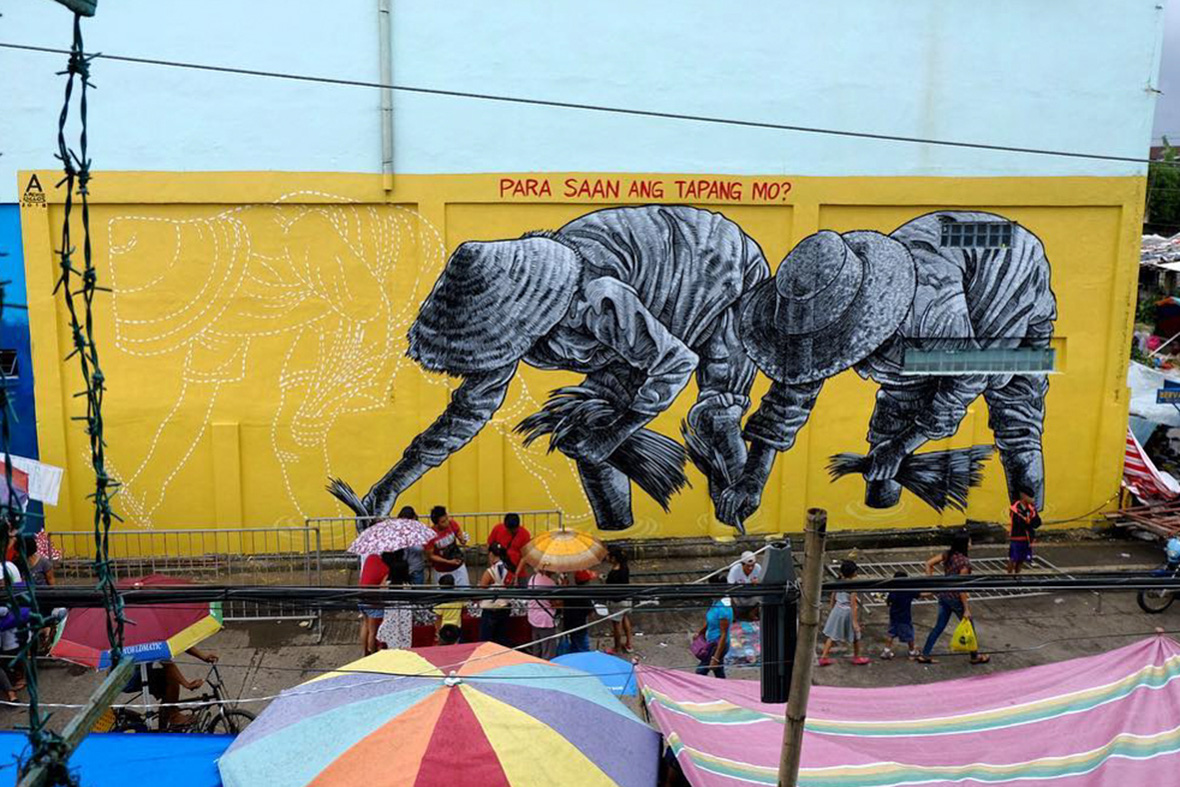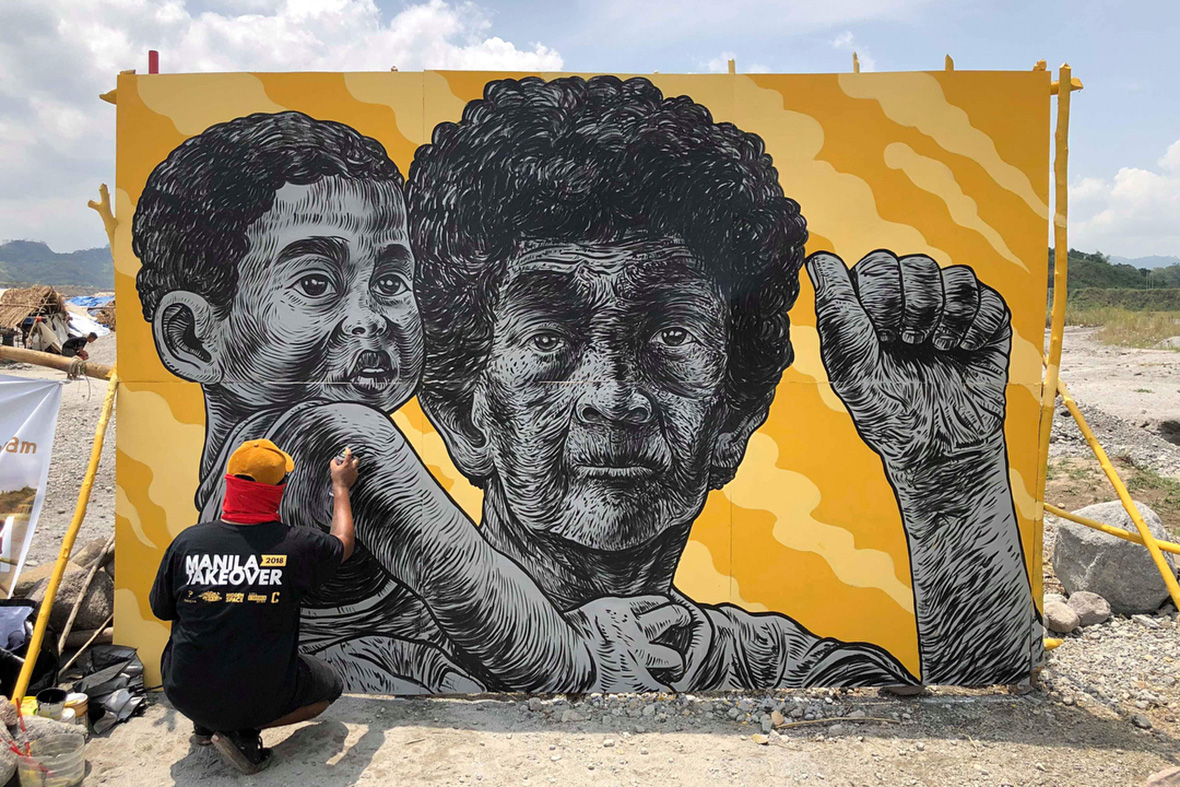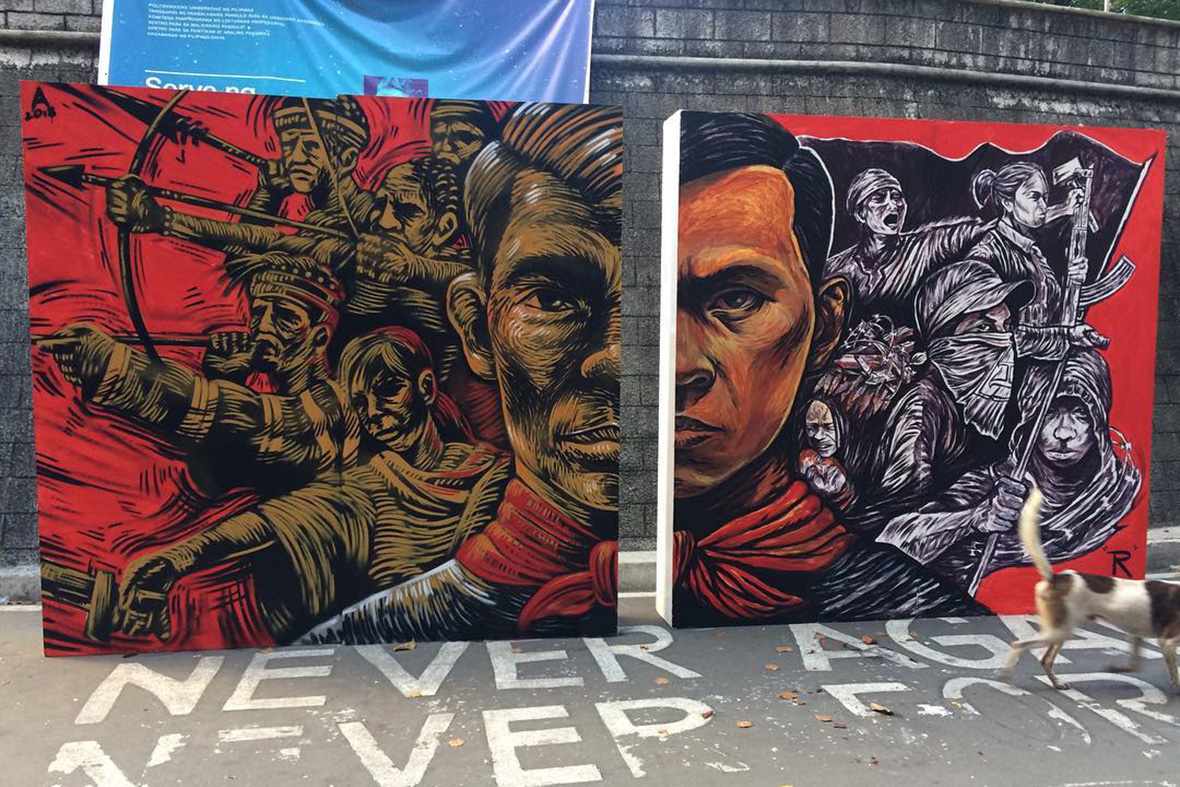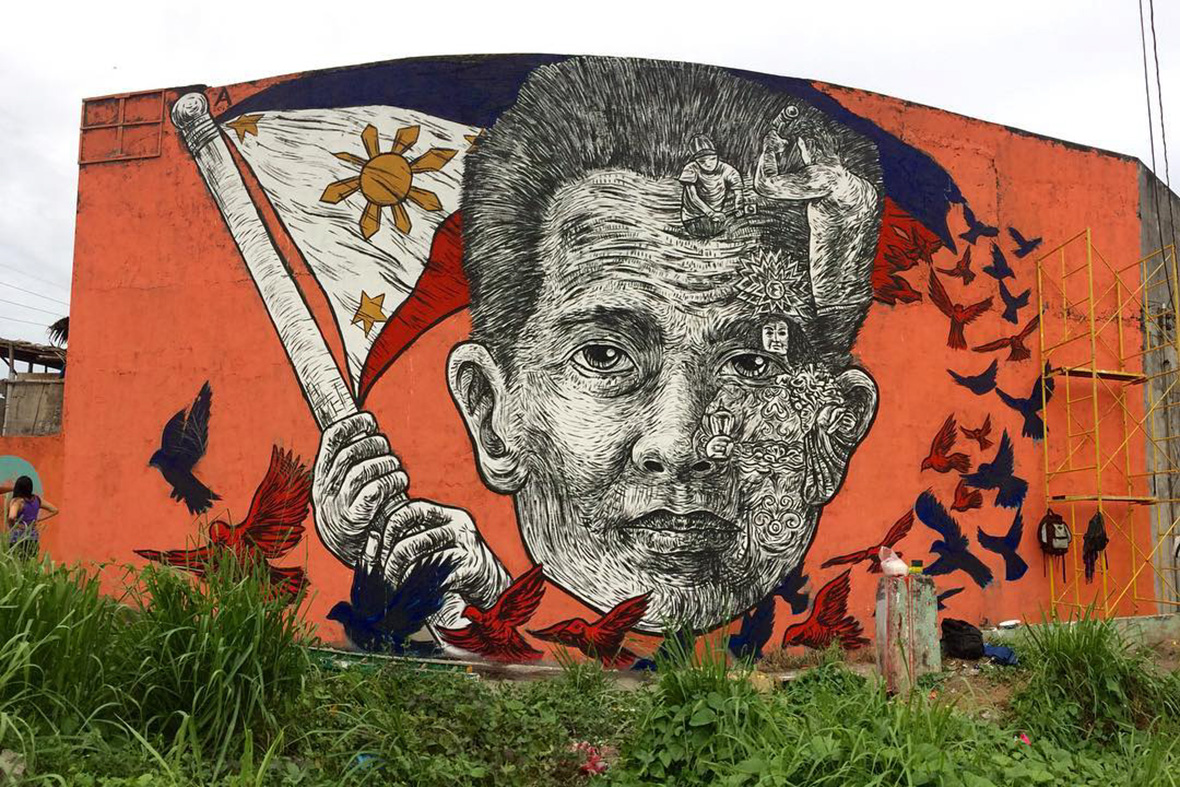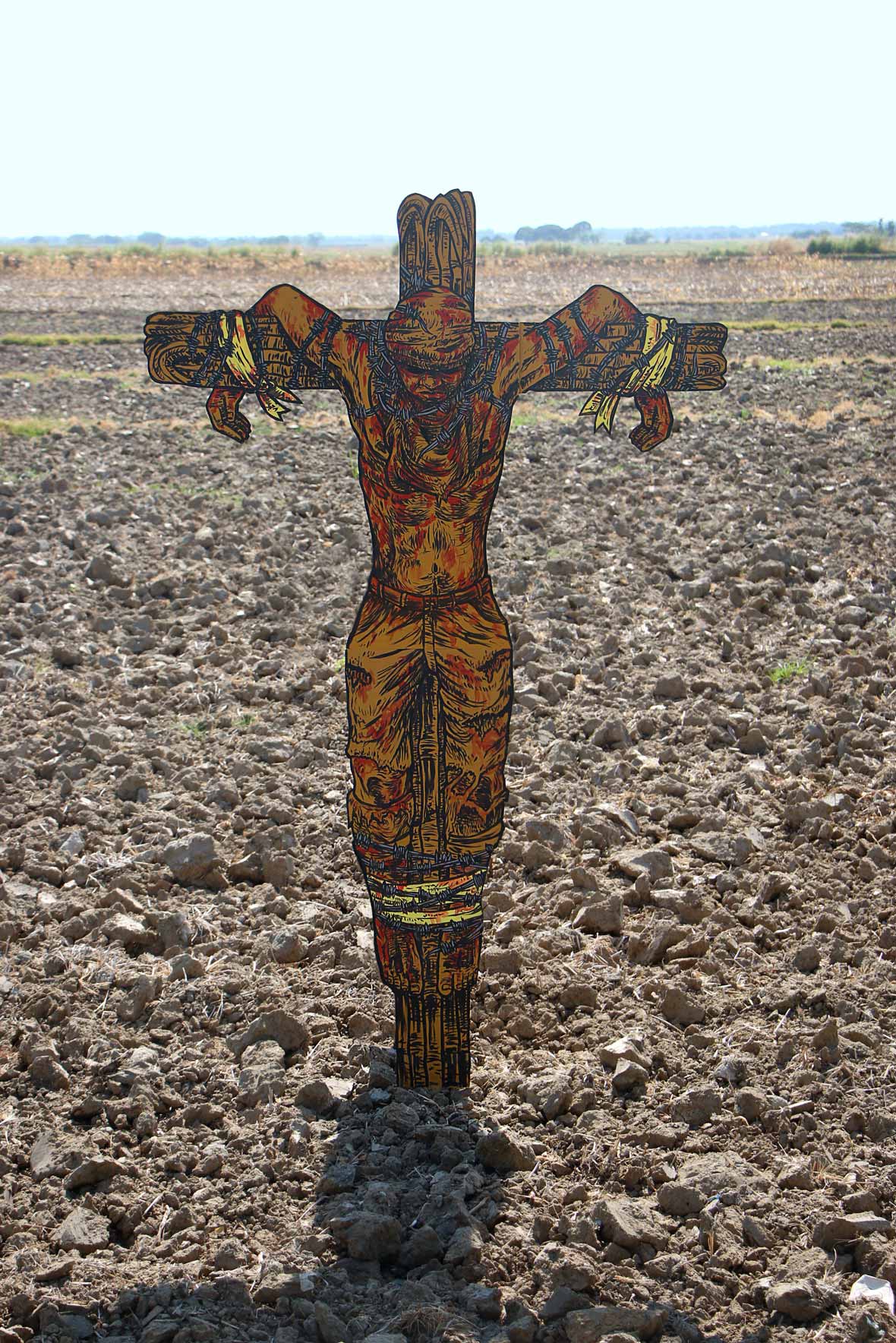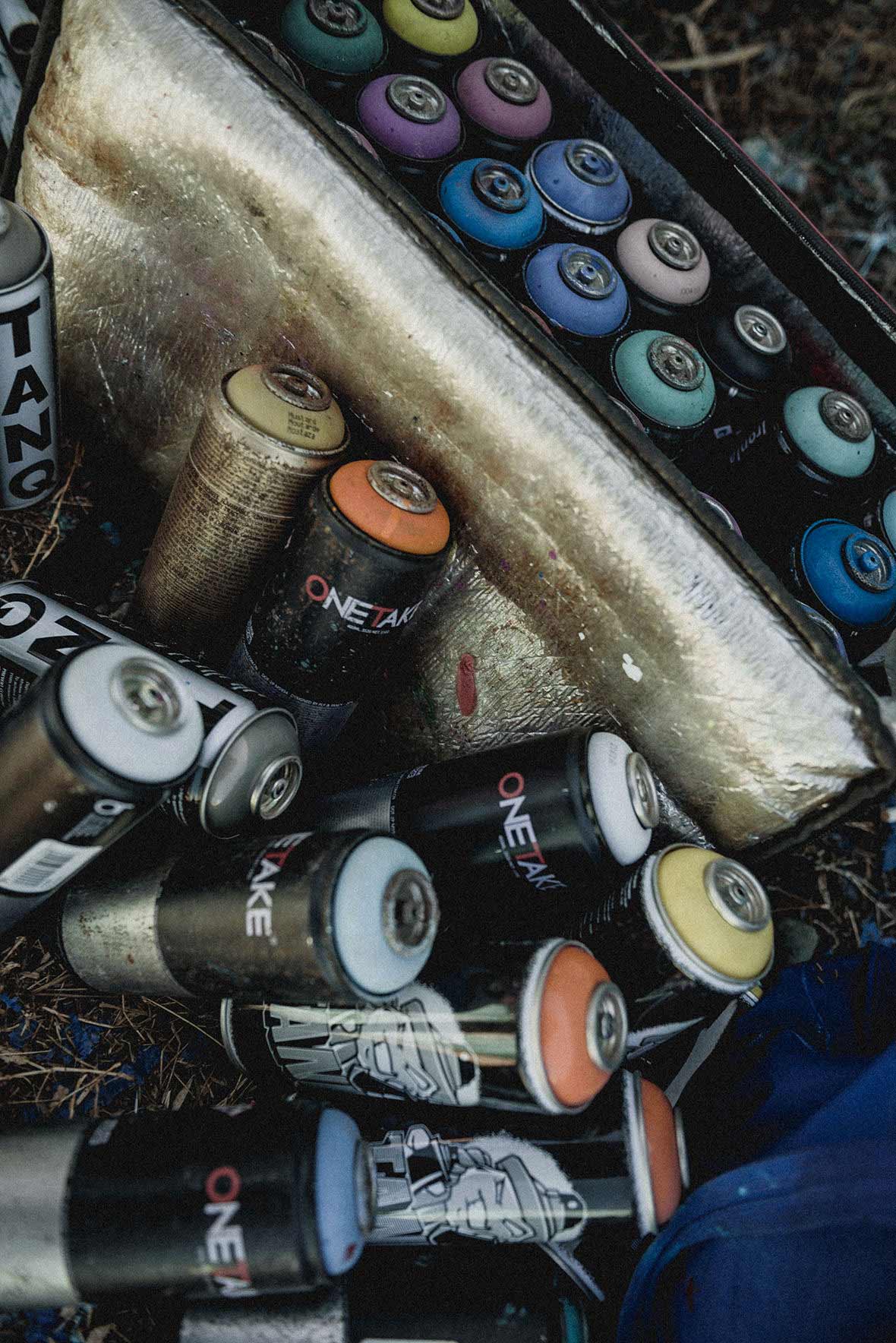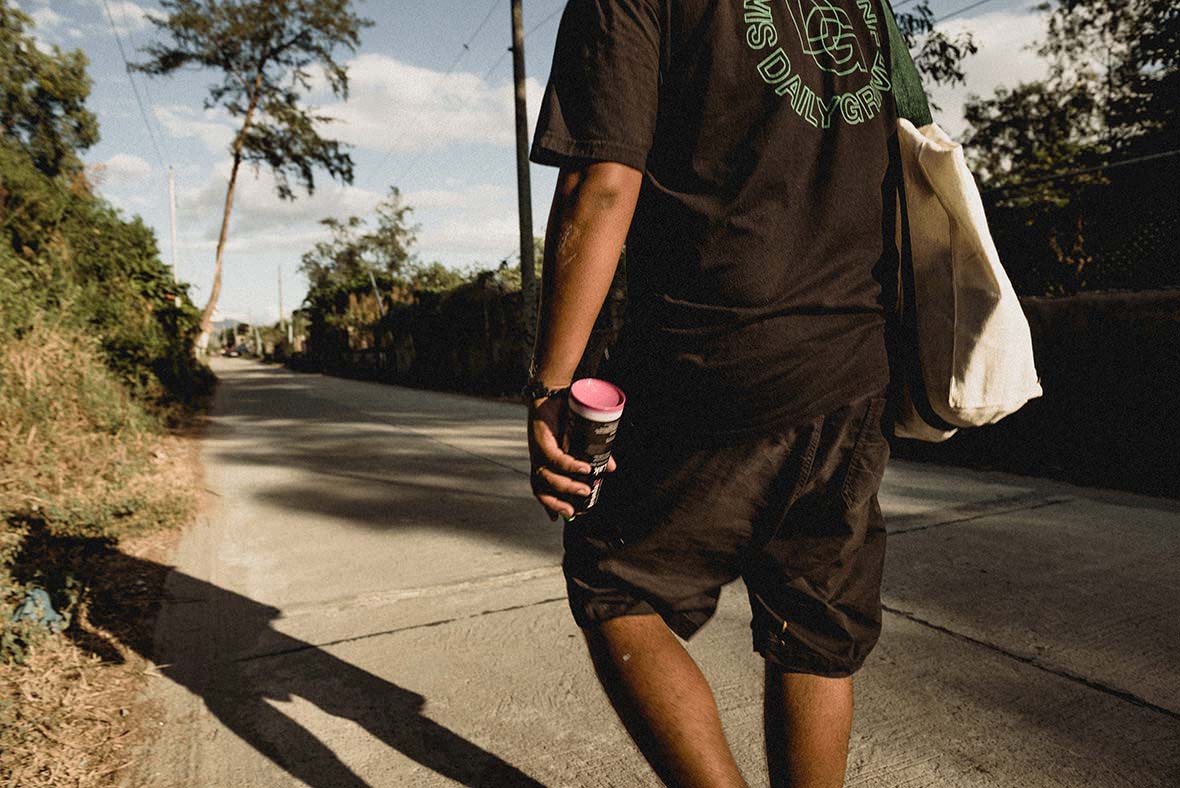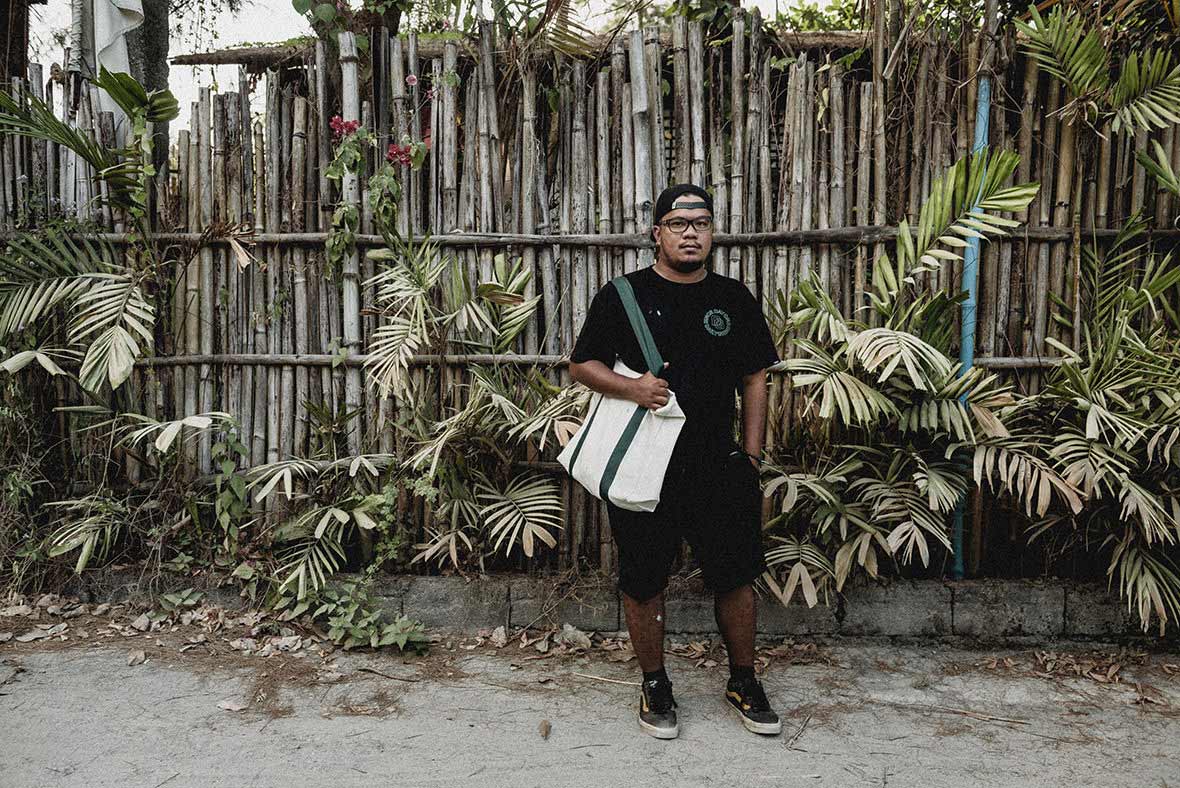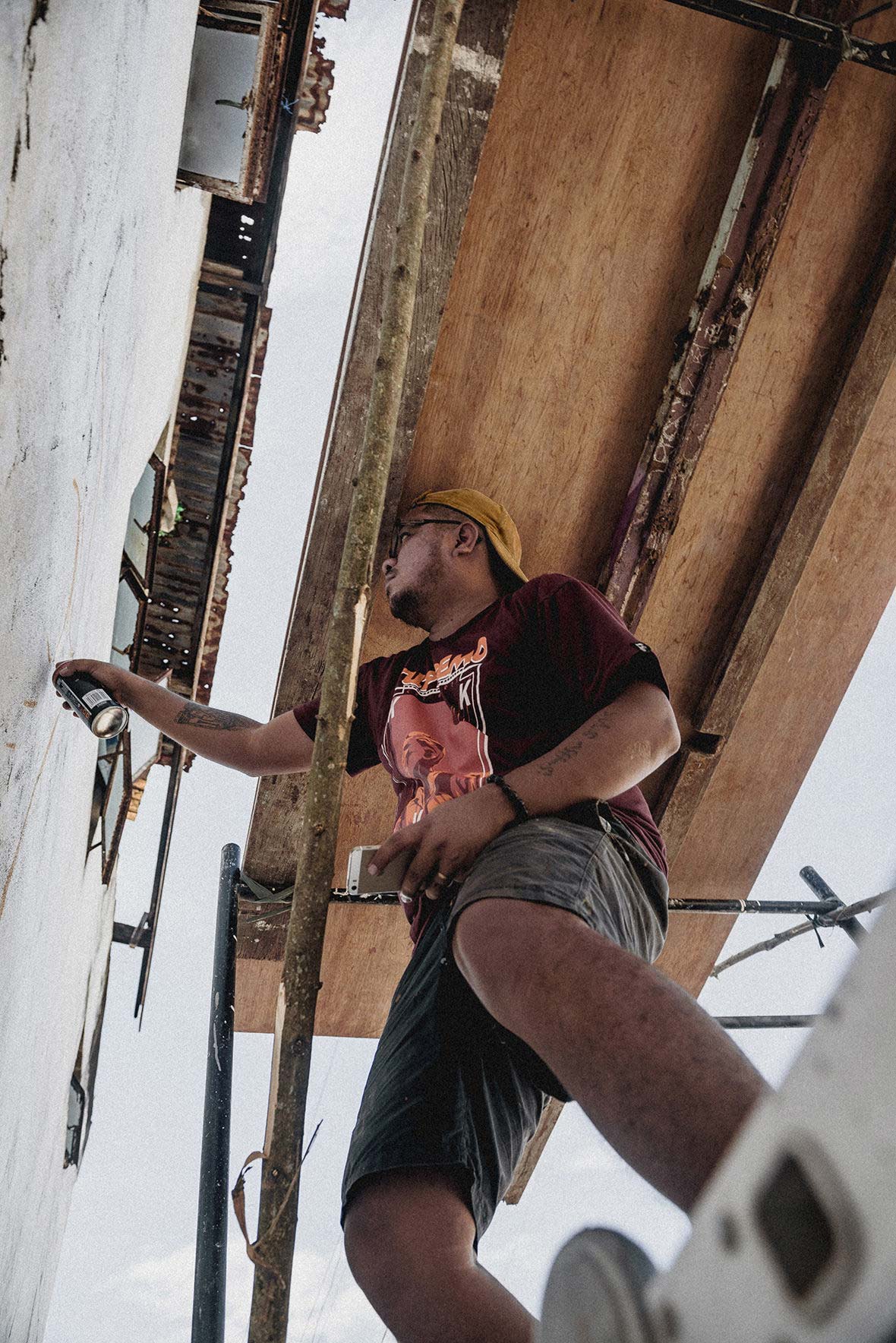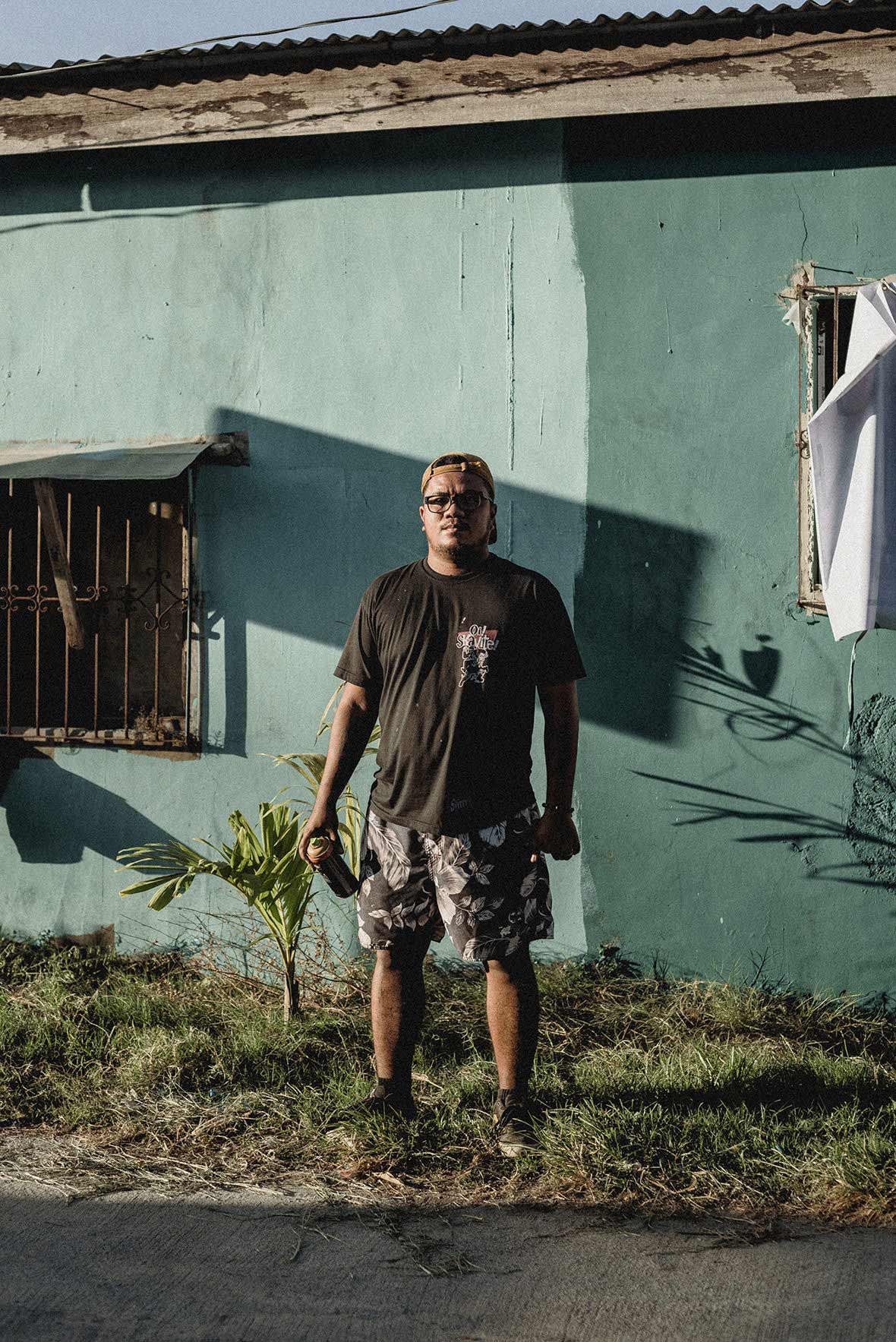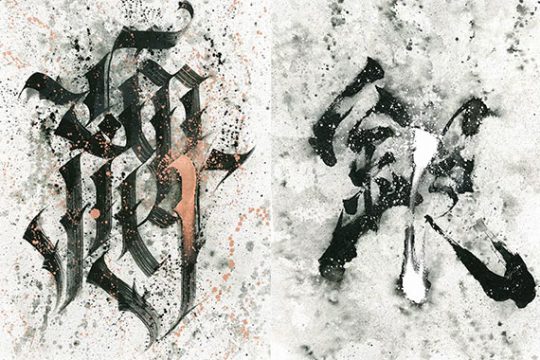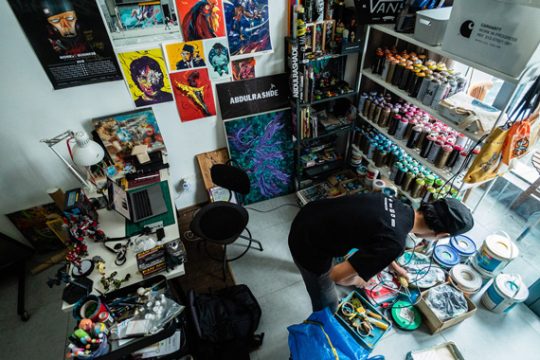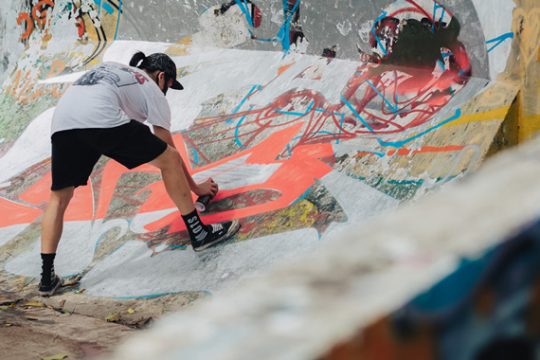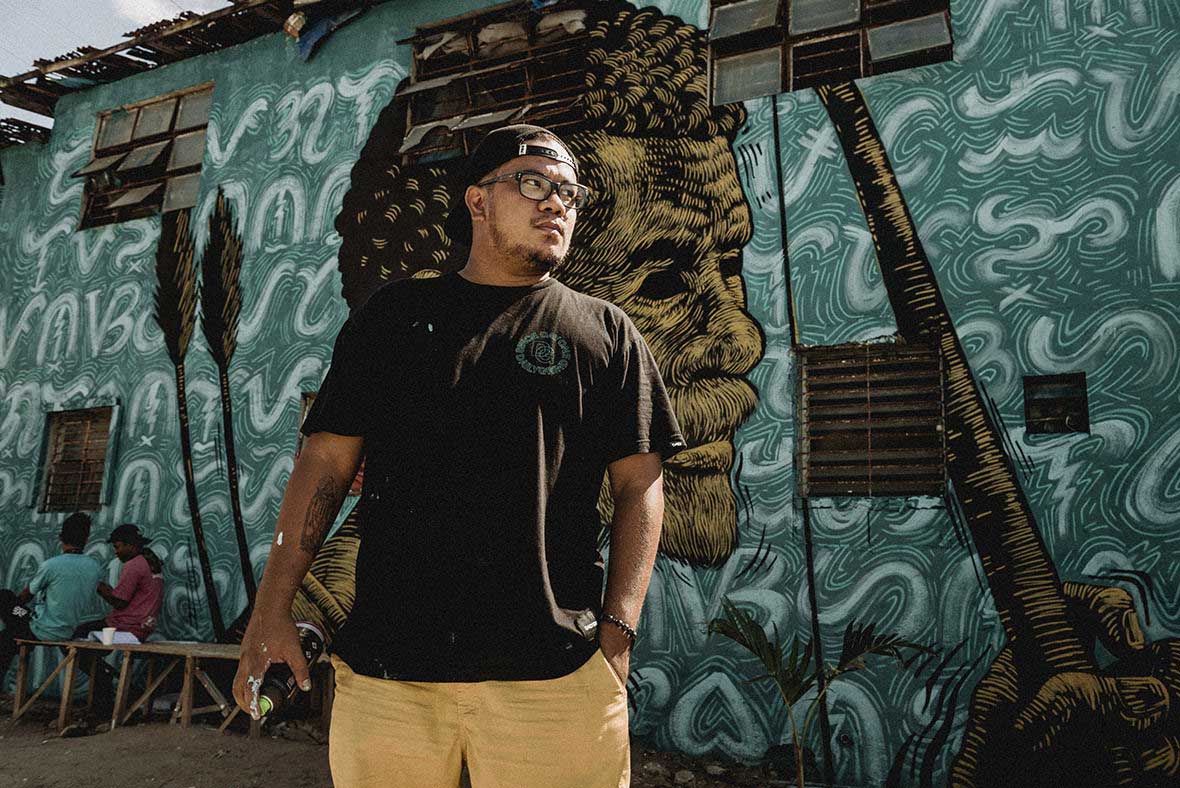
The sun shines brightly in a cloudless, blue sky while the sound of waves crash on a nearby beach. We’re in Liwa, a surfer community in the Philippines, and since it’s a weekday the town is mostly deserted, other than a few locals lounging in the shade watching Archie Oclos paint his newest mural.
Despite the sleepy setting, Oclos isn’t here on vacation—he’s on a mission. He defines himself as a provocateur, using art as a medium to broadcast discontent and raise awareness of social issues. And it’s a life that has repercussions. In a country that doesn’t tolerate dissent well, his murals have resulted in violence against him and threats to his family. But that’s only inspired him to keep working.
晴空万里,艳阳高挂,海浪拍击着附近的沙滩。这里是里瓦 (Liwa),菲律宾的一个冲浪目的地,因为是工作日,镇上一片冷清,只有几个当地人在树荫下看着 Archie Oclos 画着他的最新壁画作品。
尽管这样的环境令人昏昏欲睡,但 Oclos 不是来这里度假的,他有任务在身。他说自己是煽动者,以艺术为媒介,宣扬各种对社会问题的不满,提高人们的意识。在这个不欢迎异见的国家,他的生活自然不可能舒坦。因为创作壁画,他曾招来暴力对待,连他的家人也受到了威胁。但是,这只能进一步激励他去创作。
The profile of an indigenous character fills the center of the Liwa wall, rendered in a black silhouette with ochre line work, his bow and arrow stretching from the ground all the way to the two story roof. The character is a member of the Itas, considered to be the first inhabitants of Zambales, the province where Liwa is located. Stretching across the background in sea blue are rows of Baybayin calligraphy, a pre-colonial writing system that was used across the entire island nation at one point. A smaller line in the upper left hand side, written in Tagalog, reads “You fight for the land and take good care of it.”
Oclos’s paintings generally focus on Filipino farmers and indigenous people. “They are the minority groups in our society,” he explains. “They are the most oppressed by military and the state forces, and there are lots of stories from the rural areas that need to be told.” A good example of the issues that he works on can be found in an installation at a sugar plantation called the Hacienda Luisita. It depicts a farmer hanging on a cross. The plantation, partially owned by the family of late former president Benigno Aquino III, has been dogged over the years with accusations of murder, land theft, and appalling conditions for its workers.
在里瓦一堵墙壁上,一个土著人物的轮廓填满了墙壁中央。以赭色的线稿描画,黑色的轮廓勾勒,他的弓箭从地面一直延伸至两层楼的屋顶。这个土著人物的原型是Itas族人,据说是里瓦所处的三描礼示省 (Zambales) 的第一批居民。横跨背景的是一行行海蓝色的比比贤文字(Baybayin),这是前殖民时代曾经在整个岛国使用过的文字。在左上方,有一排较小的加禄语写着“你要为你的土地斗争,并照料好这片土地。”
Oclos 的作品画的主要都是菲律宾农民和土著人民。他解释道:“他们是我们社会的少数群体,是受军事和国家势力欺压最严重的群体。在农村有很多需要讲述的故事。”在名为 Luisita(路易斯塔庄园)的甘蔗种植园,摆放着他的一个装置艺术作品,很好地体现了他所要表达的问题。这件作品描述的是一个农民挂在十字架上的情景。这片种植园的主人之一是已故前总统阿基诺三世的家族。多年来这里一直笼罩在谋杀、盗窃土地、剥削工人的指责阴影中。
Oclos comes from a family of farmers, and his parents migrated to Manila when he was nine years old. While his mother gave up farming to become a school teacher and worked for less than minimum wage, his father couldn’t find work, and they weren’t able to escape poverty. “We moved around Manila a lot,” the painter recounts. “Surviving on a day-to-day basis was hard. There were times we went hungry, and sometimes we had only one meal of fish and rice per day.”
He wanted to be an artist since he was a little kid drawing dinosaurs and cartoons, but his parents pushed him to become a doctor or a lawyer. “They didn’t support my art because of the stereotype that artists don’t make money, that it’s just a hobby.” Although he studied hard and got a scholarship to a science high school, the bug never left him and when he left for college at age 16, he decided to study art. His fraternity helped him get another scholarship to study for free, and he supported himself by working as a photographer’s assistant.
After graduation he started working in video games. He taught himself digital painting and sent a portfolio to an online job posting, becoming a concept designer for EA Games and Disney. It wasn’t satisfying work though, and he found himself asking, “What is the purpose of art during trying times?”
Oclos 出身于一个农民家庭,9岁的时候随父母移居马尼拉。虽然他的母亲离开了农田,成为了一名学校教师,薪水低于最低工资,但父亲找不到工作,生活比较贫困。“我们在马尼拉经常要搬家。”这名画家回忆道,“这样难以为继的生活很艰苦。我们常常要挨饿,有时候一天也只能吃上一顿饭,只有鱼和米饭。
从小,他就喜欢画恐龙和漫画,梦想成为一名艺术家,但他的父母极力要求他成为医生或律师。“他们不支持我创作艺术,因为他们觉得做艺术家赚不了钱,艺术只能是一个爱好。”虽然他通过努力学习,拿到了一间科学高中的奖学金,但他始终心有不甘。16岁上大学时,他决定修读艺术专业。他的大学兄弟会帮助他获得了另一份奖学金,可以免掉学费,他再另外给一名摄影师兼职助手来赚取生活费。
毕业后,他进入视频游戏行业工作。他自学数码绘画,后来又将作品集发给一个在线招聘的帖子,然后就成为了美国艺电公司 (EA Games) 和迪斯尼 (Disney) 的概念设计师。但是,这仍然不是他想要的工作。他问自己,“在艰难的时候,艺术的作用是什么?”
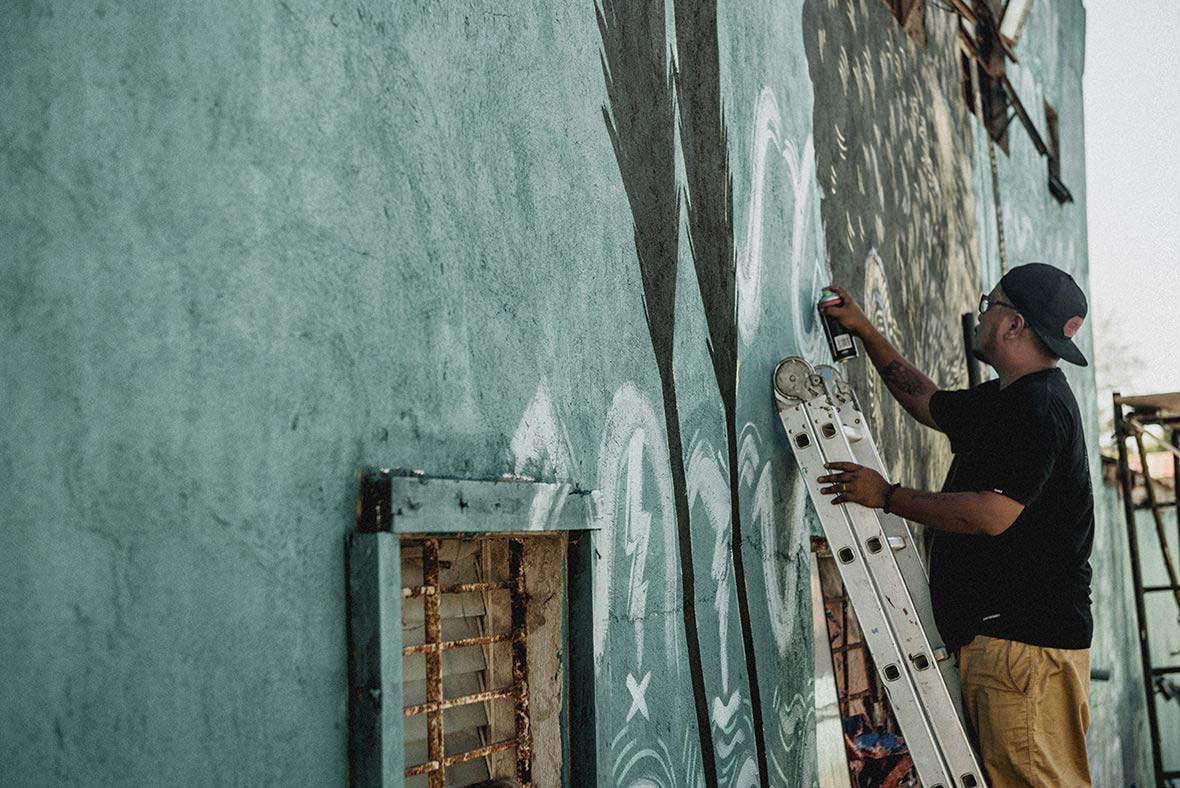
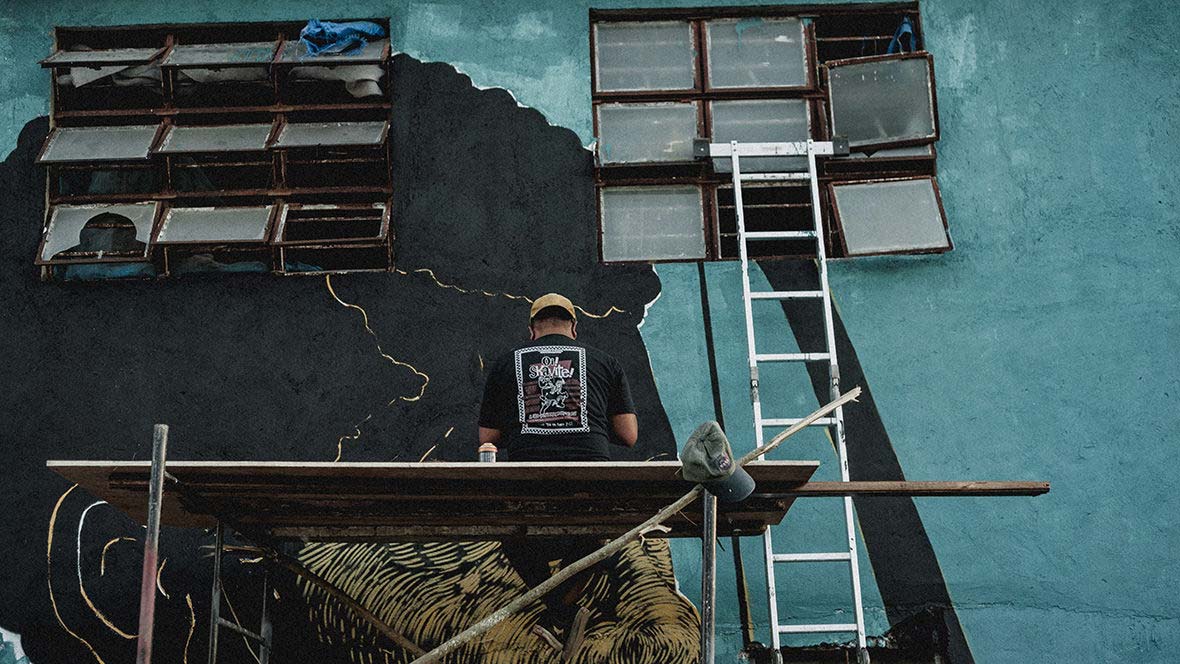
In high school he used to draw political cartoons, and during college he was part of a protest art group. So once he tired of the video game world, he went straight into political street art. Almost immediately he caught the attention of the military. As part of a 2015 event held by Food Not Bombs, an organization that gives out free food to the poor, he painted a mural of an old woman with a crown of thorns made of bullets. It was accompanied by the words, “Stop Lumad Killings,” a phrase that was trending on Twitter, sparked by a spate of murders that year of tribal leaders of the Lumad people. The Lumad are the indigenous majority in the Philippines, located mainly in Mindanao, an island at the southern end of the country. Some have accused the military of supporting the group that killed the leaders as part of a campaign to clear the land for corporations. Today, the Lumad face continued oppression, and Mindanao is currently under martial law.
高中的时候,他常常画一些政治漫画,到了大学期间,他又加入了一个抗议艺术团体。所以每当他对视频游戏世界感到厌倦时,他就会马上投身政治街头艺术。但紧接着他就引起了军方的注意。2015 年,他加入了“要食物不要炸弹反战团体” (Food Not Bombs) 组织的一次活动。这个团体常常给穷人派发免费食物。在这次活动中,他画了一个年迈的女人,头上戴着用子弹制成的荆棘冠冕。旁边写着一句话:“Stop Lumad Killing” (停止在卢马德的杀戮),这是当时上了 Twitter趋势的标签,指的是当年接连发生的针对卢马德部落领袖的谋杀事件。卢马德是菲律宾国内的主要土著部落,主要位于南部的棉兰老岛。有人指责军方,称他们是谋杀者背后的支持力量,目的是给大集团企业清除障碍。今天,卢马德依然要面对持续不断的压迫,棉兰老岛目前也处于戒严。
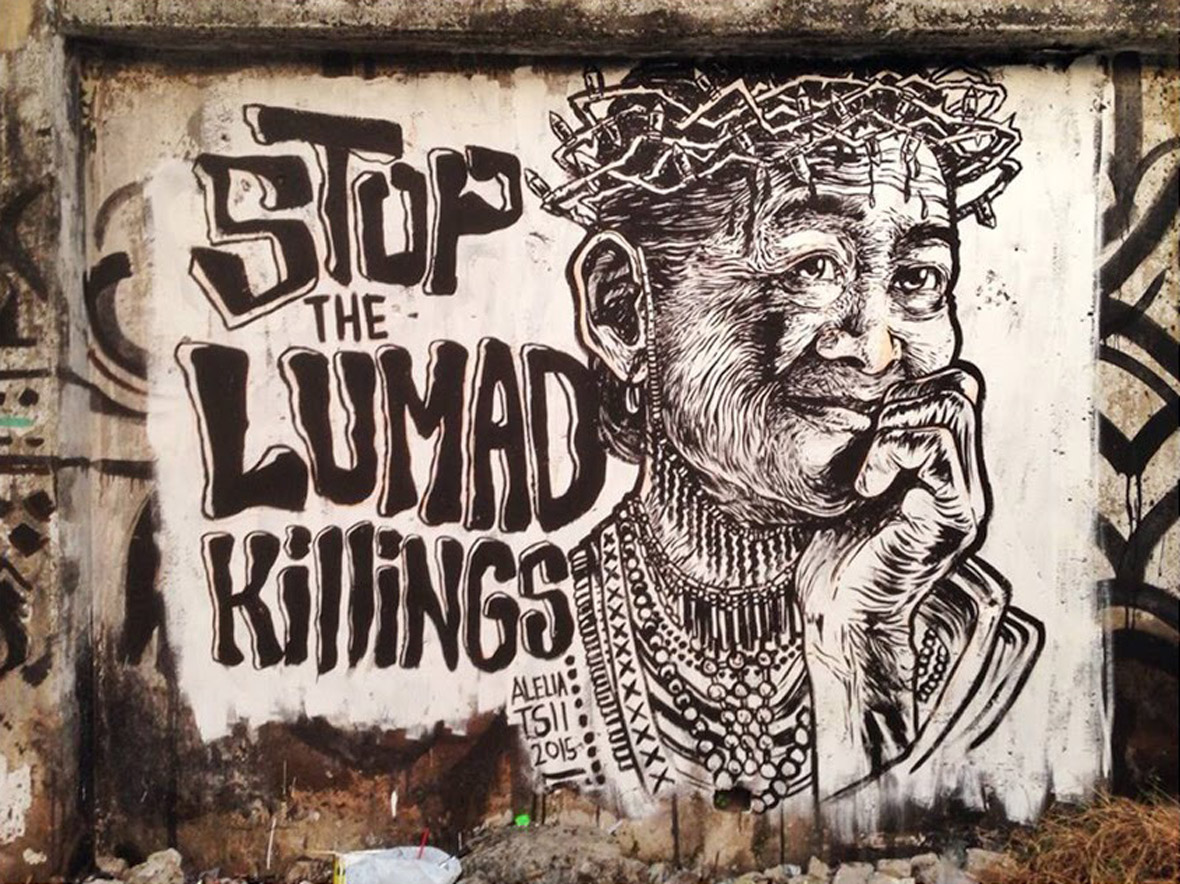
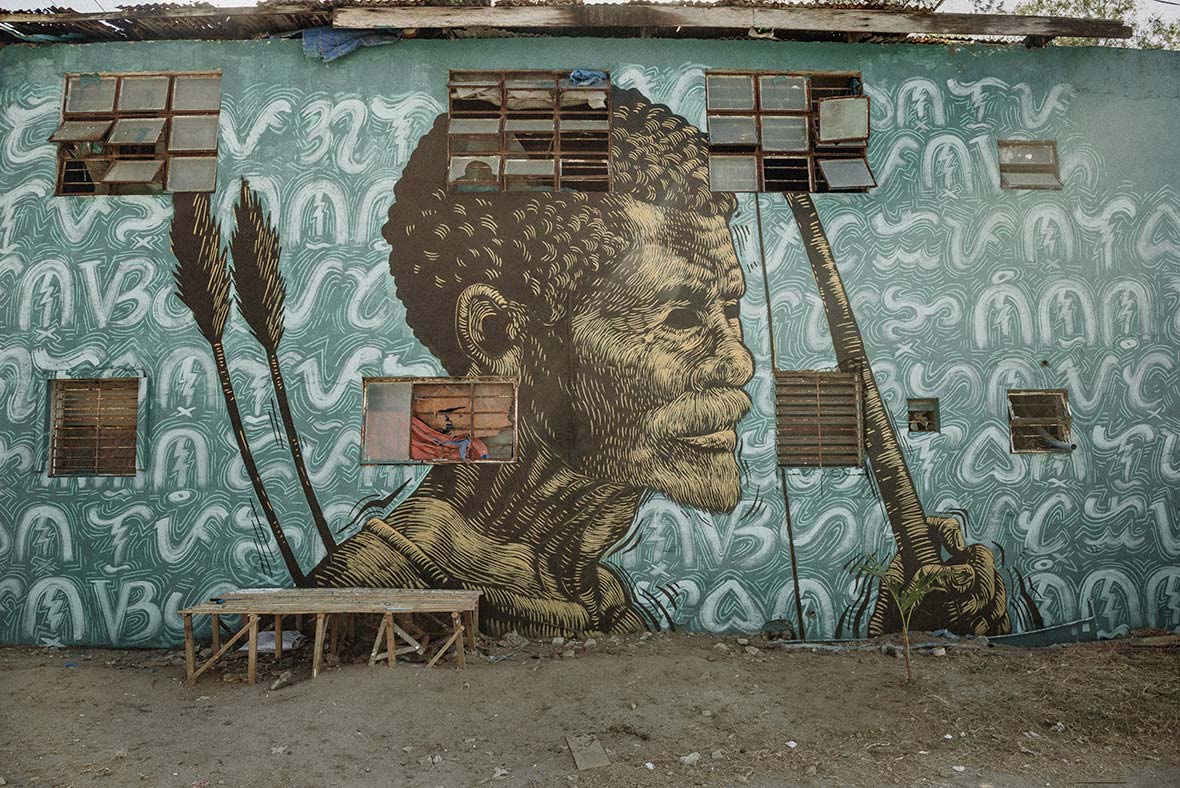
Early one morning a short while later, someone in plain clothes approached Oclos on his way to work and put him in a headlock, choking him. After wrestling for a few moments, the man let him go. “I could tell he was military because of his hair cut, his muscles, and the way he talked. There were three or four of them, and the others were guarding him,” Oclos says. The man told him he knew who he was and where he lived. “Then he gave me a brown envelope containing pictures of my girlfriend, who is now my wife, and a lot of my relatives: my grandparents, uncles, parents—even the kids, my cousins.”
It backfired, though, and rather than scare him off, it motivated him to paint even more: “It made me see the power of street art. Simple, two-dimensional art with no sound or moving images can still impact the system. It’s a way to speak up.”
Oclos 在上班途中突然被一个身穿便服的陌生男子用手卡住脖子,让他难以呼吸。争斗了几分钟后,那名陌生男子就放了他走。“我知道他是军队的人,他的发型、肌肉和说话的方式让我确信这一点。他们有三四个人,其他人就在旁边帮他守着。” Oclos 说道。那个男人说知道他是谁,也知道他住的地方。“然后,他给了我一个棕色信封,里面是我当时的女朋友,也是我现在的妻子的照片,还有我很多亲人的照片:我的爷爷奶奶、叔叔、父母,甚至还有小孩,我的表兄弟。”
然而,这次事件却并没有把他吓跑,而是促使他继续创作更多作品。“这让我看到了街头艺术的力量。这种简单、二维平面的艺术,没有声音或动图,却仍可以影响到社会。这是人们发声的一种方式。”

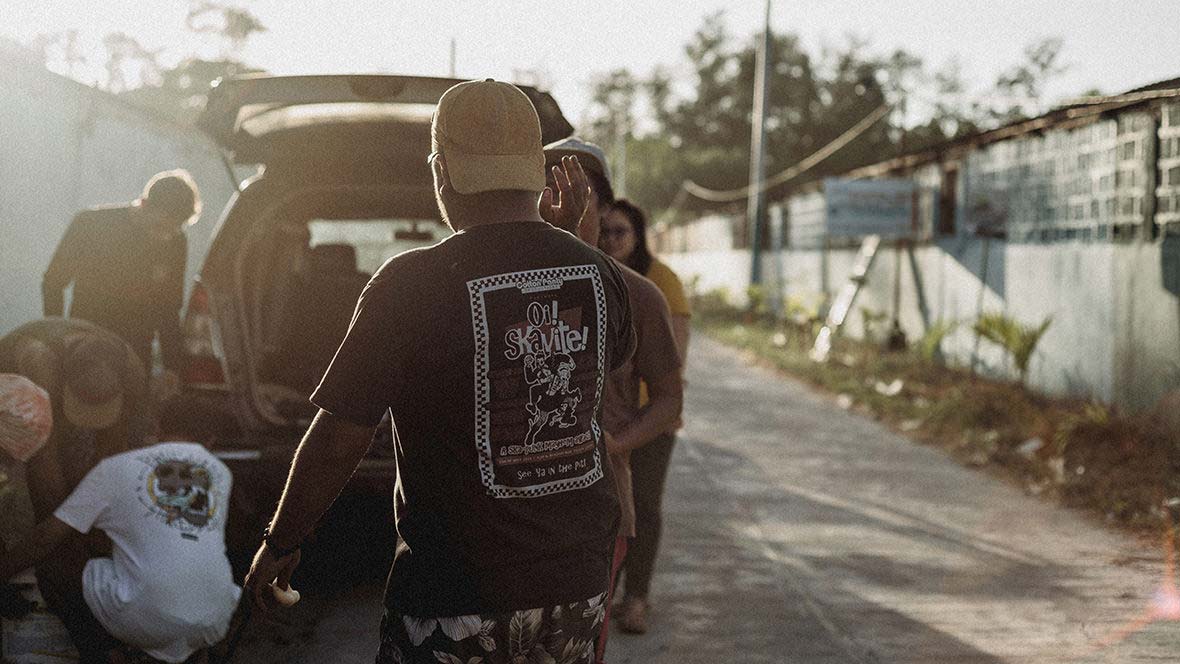
Recently, Oclos created his biggest political work to date, tackling the subject of extra-judicial killings here. After winning a Thirteen Artists award from the Cultural Center of the Philippines, one of the nation’s highest recognitions in the arts, he painted a mural on one of their outdoor walls. It depicted a dead body, rendered in black lines on a white background. He says the more than 20,000 strokes that make up the piece represent the amount of people estimated to have been killed in the country’s drug war led by the president, Rodrigo Duterte.
近日,Oclos 创造了他至今最大幅的政治主题作品,主题是当地法外处决的问题,并获得了菲律宾文化中心颁发的 Thirteen Artists 大奖——菲律宾艺术界最高奖项之一。随后,他又在一幢户外墙上绘画了一幅壁画作品,用黑色线条在白色背景上画了一具尸体。他说,这幅作品共画了2万多笔,代表了人们所估计在该国毒品战争中被杀害的人的数量。这场毒品战争是由菲律宾总统罗德里戈·达特 (Rodrigo Duterte) 所发起的。
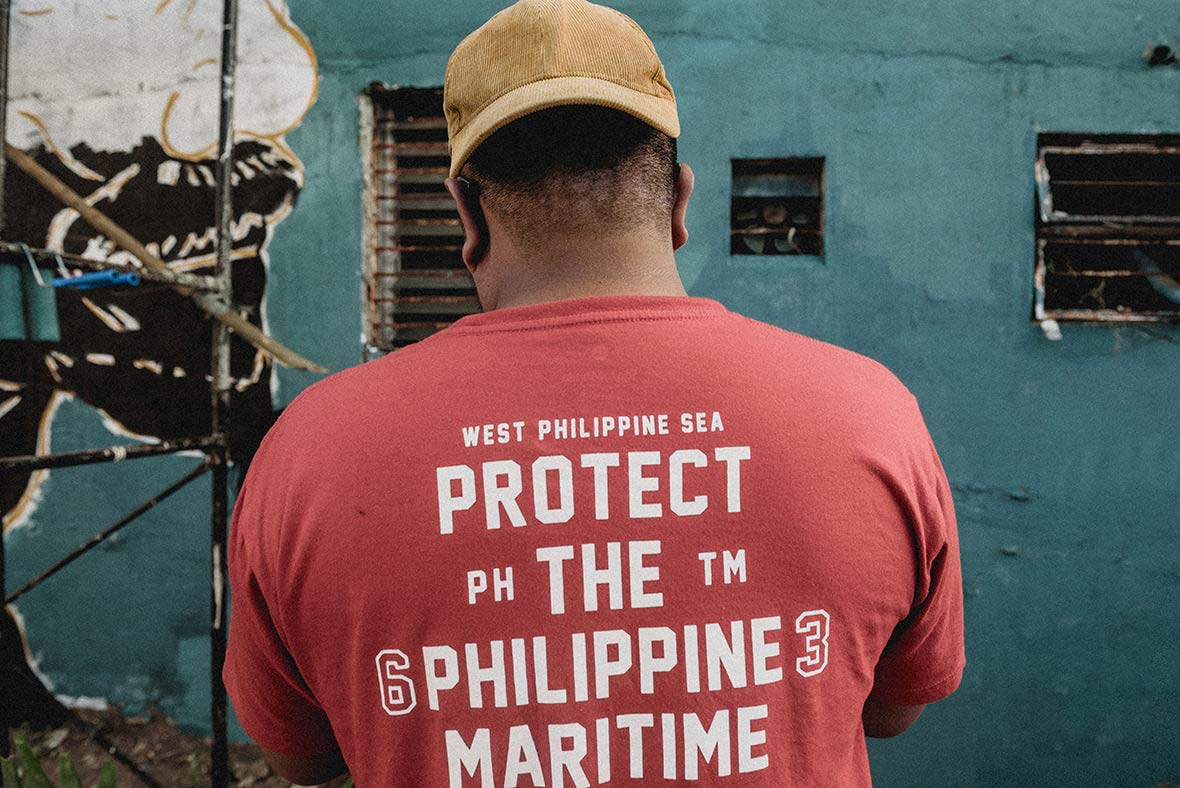
While taking a break from painting the mural, an elderly woman approached Oclos, saying that the piece was inappropriate, that it was overly negative. “I tried to convince her that we should see the face of death in order to appreciate the value of life,” Oclos argues. “Nowadays killing is normalized, which conditions people into thinking it’s okay to kill people. But it’s not.”
休息的时候,一位年迈的妇女上前跟Oclos说画这样的画不合适,太过消极了。“我试图说服她,我们应该直面死亡,才能体会生命的价值。” Oclos解释道,“如今杀戮被常规化,让人们慢慢对杀戮这个问题麻木起来。但这是不对的。”
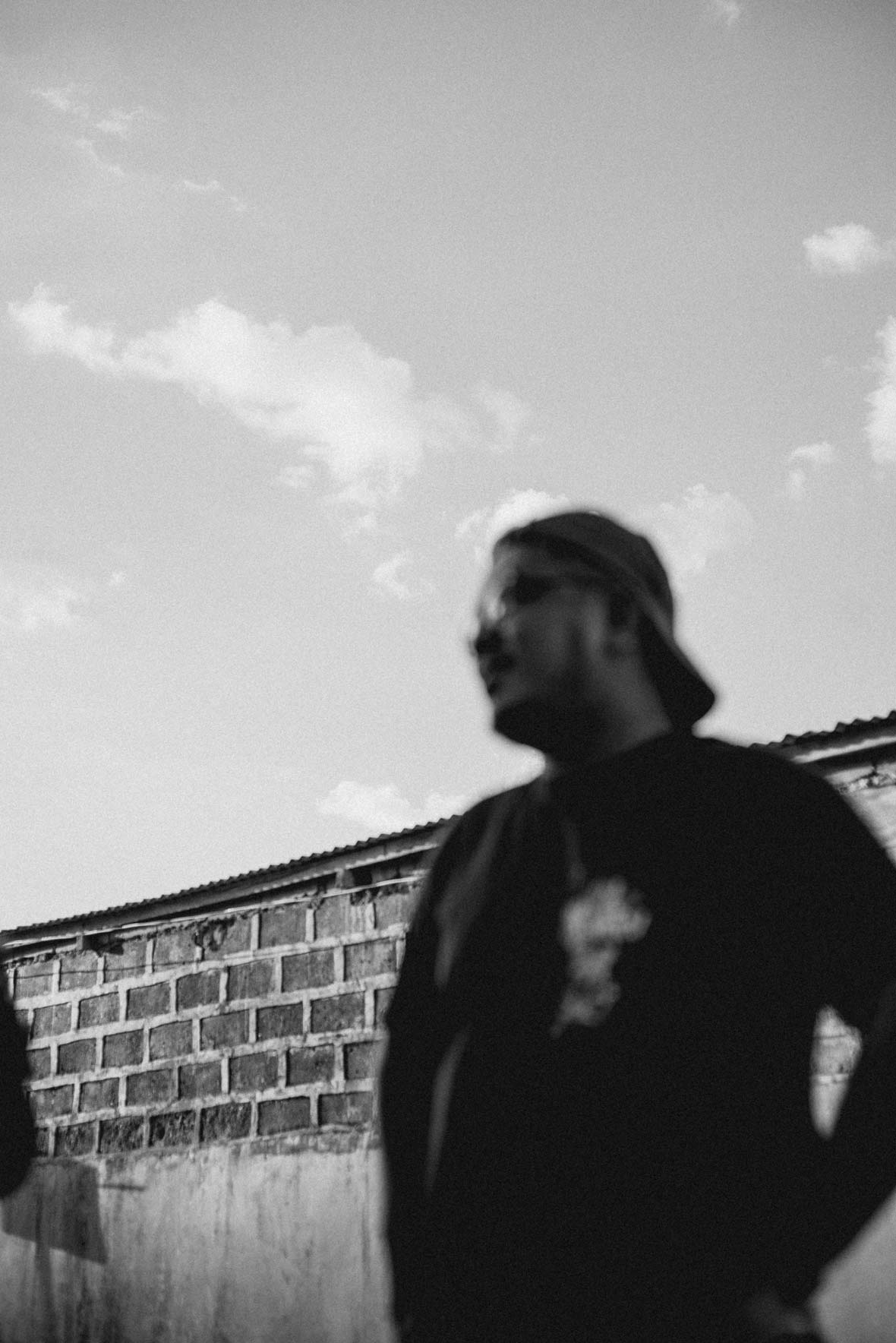
Instagram: @tatak_a
Contributor: Mike Steyels
Photographer: Ed Enclona
Chinese Translation: Olivia Li
Additional Images Courtesy of Archie Oclos

